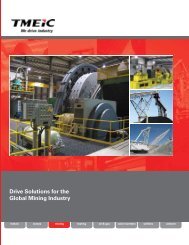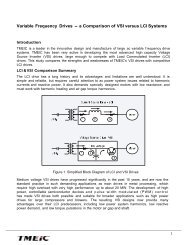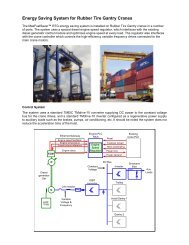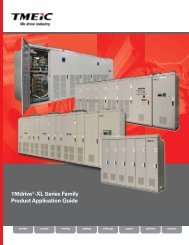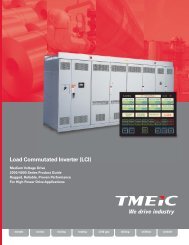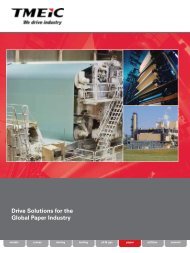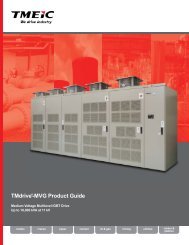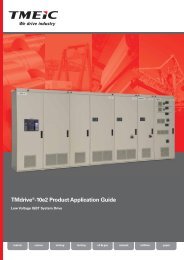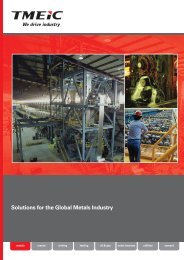Drive Solutions for the Global Cement Industry (email) - Tmeic.com
Drive Solutions for the Global Cement Industry (email) - Tmeic.com
Drive Solutions for the Global Cement Industry (email) - Tmeic.com
Create successful ePaper yourself
Turn your PDF publications into a flip-book with our unique Google optimized e-Paper software.
Application 3. Starting Multiple Mill Motors<br />
Customer installations at two adjacent cement plants use variable frequency drives <strong>for</strong> a number of applications. At <strong>the</strong>se<br />
plants, eight motors ranging from 250 to 2,400 hp are driven by TMEIC medium voltage drives, and <strong>the</strong>re are six large mill<br />
motors, each one requiring a medium voltage motor of 4,000 hp size.<br />
The cement <strong>com</strong>pany had several requirements<br />
when selecting <strong>the</strong>ir six large mill motors, and<br />
associated drives and controls, including:<br />
• Ability to soft start any of <strong>the</strong> motors from<br />
any drive and reduce <strong>the</strong> impact on <strong>the</strong><br />
power system.<br />
• Ability to synchronize <strong>the</strong> motors with <strong>the</strong><br />
utility supply and run some or all of <strong>the</strong><br />
motors on <strong>the</strong> utility supply at constant<br />
speed.<br />
• Ability to run one motor at variable speed<br />
to allow grinding process optimization<br />
• Use synchronous motors, because<br />
synchronous motors can supply leading<br />
VARs to <strong>the</strong> power supply system to help<br />
correct poor plant power factor.<br />
Synchronous Motor <strong>for</strong> Mill<br />
After reviewing <strong>the</strong>ir alternatives, <strong>the</strong> <strong>com</strong>pany<br />
decided to install a TMEIC VFD in each plant to<br />
individually soft start <strong>the</strong> three mill motors. In<br />
addition, since <strong>the</strong> two plants are adjacent, it<br />
was decided to install a tie contactor allowing<br />
any VFD to start any mill motor in ei<strong>the</strong>r plant,<br />
providing backup in case of any problems.<br />
Benefits of <strong>the</strong> Variable Frequency <strong>Drive</strong> and Synchronous Motors<br />
Cost Savings – The customer’s analysis indicated excellent savings by using synchronous motors because<br />
<strong>the</strong>y correct <strong>the</strong> power factor <strong>for</strong> <strong>the</strong> whole plant, and <strong>the</strong>y have a high efficiency. In this location <strong>the</strong> utility<br />
charges users a penalty <strong>for</strong> low power factor operation.<br />
High Reliability – The VFD has a proven history of high reliability. Sharing <strong>the</strong> two VFDs between <strong>the</strong> six<br />
motors using power switches yields an availability of better than 99.999%.<br />
Smooth Motor Starting – The VFD controls <strong>the</strong> rotor field (through <strong>the</strong> exciter) and <strong>the</strong> stator current to<br />
provide a smooth starting profile without exceeding rated volts and amps, <strong>the</strong>reby protecting <strong>the</strong> motor<br />
against overheating. Controlling <strong>the</strong> motor current is also important where power system grids are weak<br />
or <strong>the</strong> plant is at <strong>the</strong> end of a long transmission line. In addition to starting, <strong>the</strong> VFD provides smooth<br />
motor synchronizing with <strong>the</strong> supply.<br />
Page 8 of 28<br />
© 2011 TMEIC Corporation. All Rights Reserved.



